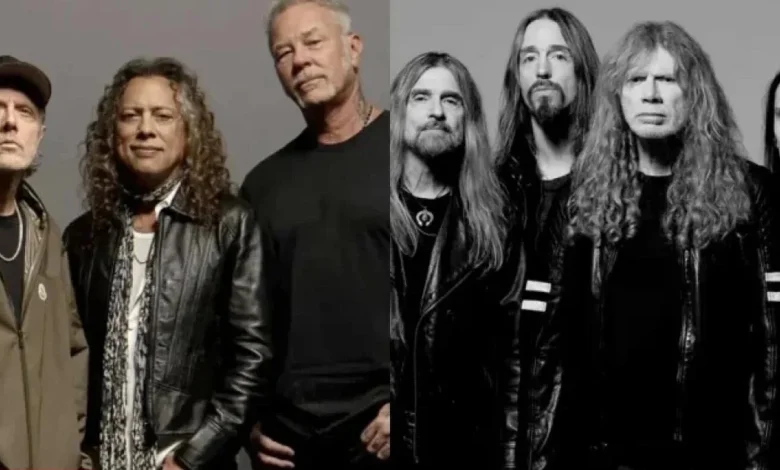Metallica’s Reign: Rivalries, Roots, and the Legacy of Thrash Metal

Quick Read
- Metallica and Megadeth’s rivalry began with Dave Mustaine’s departure from Metallica in 1983.
- Kerry King of Slayer recently stated his preference for Metallica’s James Hetfield over Mustaine.
- Megadeth’s upcoming final album will include a cover of Metallica’s ‘Ride The Lightning’.
- The relationship between the bands has warmed, with past collaborations and mutual respect.
- Metallica continues to tour globally, underscoring their lasting influence in thrash metal.
Inside the Metallica-Megadeth Rivalry: Where It All Began
If you ask any heavy metal fan to name the genre’s most iconic rivalry, chances are they’ll land on Metallica and Megadeth. It’s not just a tale of two bands—this is a story of ambition, heartbreak, and the relentless pursuit of musical greatness. Recently, Slayer’s Kerry King revisited this legendary feud, offering a rare window into its emotional undercurrents and historic milestones (EMEgypt).
The roots of the rivalry go deep. Back in 1983, Metallica made the difficult decision to let go of their founding guitarist, Dave Mustaine, citing issues with substance abuse. Mustaine’s departure wasn’t just a personnel change—it was the spark that ignited Megadeth’s formation. Fueled by frustration and a burning desire to outshine his former bandmates, Mustaine established Megadeth, vowing to push musical boundaries even further. Kirk Hammett stepped in as Metallica’s new lead guitarist, and the stage was set for a clash that would captivate fans for decades.
The “Big Four” and the Pulse of Thrash Metal
Metallica and Megadeth quickly rose to prominence, joining Slayer and Anthrax as the so-called “Big Four” of thrash metal. While Metallica soared to mainstream stardom, Megadeth carved out a dedicated following, revered for their technical prowess and biting lyrics. The rivalry, however, wasn’t just about record sales—it became a driving force behind the genre’s evolution. As Kerry King observed in a recent interview with Reigning TV, the competition pushed both bands to innovate, setting new standards for speed, aggression, and complexity.
King didn’t shy away from taking sides. When asked about the frontmen, he candidly stated, “I know I played in your band, but I’m going with James,” referring to Metallica’s James Hetfield. His preference echoed a common sentiment among musicians and fans: Hetfield’s magnetic stage presence and songwriting have often put Metallica a step ahead in the public eye.
From Feud to Friendship: Turning Points and Reconciliation
Despite the bitterness that marked their early years, the relationship between Metallica and Megadeth has softened over time. Mustaine’s appearance in Metallica’s documentary “Some Kind of Monster” laid bare the emotional scars left by his firing, but it also opened the door to dialogue. The two bands shared the stage during a series of concerts in 2010 and 2011, performing together and reminding audiences that, at the core, their stories are intertwined.
Yet, the competitive spirit never fully faded. Mustaine’s drive to prove himself resulted in a prolific career for Megadeth, even as Metallica dominated the charts. It’s a rivalry that’s less about animosity now and more about mutual respect—a testament to the healing power of time and music.
Honoring the Past: Megadeth’s Final Album and Metallica’s Enduring Influence
In a poignant twist, Megadeth recently announced their upcoming album will be their last. Mustaine revealed that one track would be a cover of Metallica’s “Ride The Lightning”—a song he co-wrote with Hetfield, Lars Ulrich, and Cliff Burton before his departure. It’s a gesture that speaks volumes, bridging decades of competition with a nod to shared origins.
“Covering ‘Ride The Lightning’ isn’t just about honoring Metallica,” Mustaine explained. “It’s about reconnecting with my own roots, with the music that started it all.” The cover is set to be both a farewell and a tribute, marking the end of Megadeth’s journey while celebrating the legacy of thrash metal’s pioneers.
Mustaine has also expressed a desire to reconnect with Hetfield, suggesting that, while time may have changed their relationship, there’s still room for camaraderie. “I know I would like to hang out and listen to new music,” he said, hinting at the possibility of future collaborations or, at the very least, reconciliation.
Metallica’s Ongoing Dominance and the Future of Thrash Metal
While Megadeth prepares to bow out, Metallica shows no signs of slowing down. The band recently wrapped up a leg of their latest tour in Australia, with a packed show in Perth that drew fans from across the region. Their continued global presence underscores Metallica’s staying power—a band that has weathered internal strife, changing musical landscapes, and the pressures of fame to remain at the top of their game.
The story of Metallica and Megadeth isn’t just about rivalry—it’s about survival. Both bands have faced setbacks, controversies, and personal struggles, yet their commitment to music has never wavered. Today, their influence can be heard in countless acts that followed, from stadium-filling supergroups to underground upstarts hoping to capture a fraction of their energy.
Legacy in Motion: The Big Picture
What does the enduring rivalry between Metallica and Megadeth teach us? For starters, it reminds us that competition can be a powerful catalyst for creativity. The friction between these bands pushed them to new heights, fueling innovation that defined a generation. It’s a dynamic echoed across the music world—where egos clash, but the audience wins.
The so-called “Big Four” didn’t just play fast and loud; they inspired a movement. Metallica, in particular, has become a symbol of resilience and reinvention, adapting their sound and approach to stay relevant in a rapidly changing industry. Megadeth, meanwhile, proved that vision and determination could carve out a lasting legacy, even in the shadow of giants.
Final Notes: Reconciliation or Reinvention?
As Megadeth closes the chapter on their career and Metallica continues to tour, the thrash metal scene stands at a crossroads. Will future generations see a new wave of rivalries, or will the lessons of the past lead to more collaboration and mutual support? Only time will tell, but one thing is certain: the legacy of Metallica and Megadeth will continue to shape heavy music for years to come.
Metallica’s journey from rivalry to reconciliation with Megadeth reveals the true heart of thrash metal—where passion, competition, and respect drive both innovation and healing. The genre’s greatest story is far from over; it’s simply evolving, echoing in every riff, lyric, and moment of connection between artists and fans.





